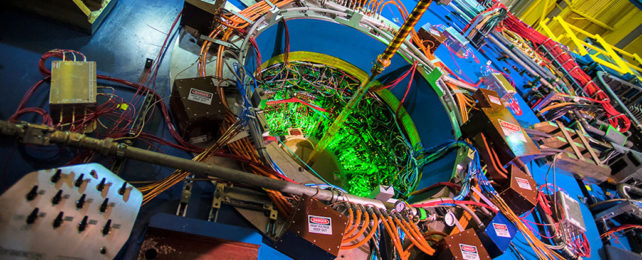Silently churning away at the heart of every atom in the Universe is a swirling wind of particles that physics yearns to understand.
No probe, no microscope, and no X-ray machine can hope to make sense of the chaotic blur of quantum cogs whirring inside an atom, leaving physicists to theorize the best they can based on the debris of high-speed collisions inside particle colliders.
Researchers now have a new tool that is already providing them with a small glimpse into the protons and neutrons that form the nuclei of atoms, one based on the entanglement of particles produced as gold atoms brush past each other at speed.
Using the powerful Relativistic Heavy Ion Collider (RHIC) at the US Department of Energy's Brookhaven National Laboratory, scientists have shown how it's possible to glean precise details on the arrangement of gold's protons and neutrons using a kind of quantum interference never before seen in an experiment.
"This technique is similar to the way doctors use positron emission tomography (PET scans) to see what's happening inside the brain and other body parts," says physicist James Daniel Brandenburg, formerly a Brookhaven researcher and now a member of the STAR collaboration.
"But in this case, we're talking about mapping out features on the scale of femtometers – quadrillionths of a meter – the size of an individual proton."
In textbook terms, the anatomy of a proton can be described as a trio of fundamental building blocks called quarks bound together by the exchange of a force-carrying particle called a gluon.
Were we to zoom in and observe this collaboration firsthand, we'd see nothing so neat. Particles and antiparticles pop in and out of existence in a seething foam of statistical madness, where the rules on particle distribution are anything but consistent.
Putting constraints on the movements and momenta of quarks and gluons requires some clever thinking, but hard evidence is what physicists really desire.
Unfortunately, simply shining a light onto a proton won't result in a snapshot of its moving parts. Photons and gluons play by very different rules, meaning they are effectively invisible to one another.
There is a loophole, however. Imbued with enough energy, waves of light can occasionally churn up pairs of particles that sit on the brink of existence before vanishing again, among which are quarks and antiquarks.
Should this spontaneous emergence occur within earshot of an atom's nucleus, the poltergeist flicker of opposing quarks could mix with the swirling volleys of gluons and temporarily form a conglomerate known as a rho particle, which in a fraction of a second shatters into a pair of charged particles called pions.
Those pairs consist of a positive pion, composed of an up quark and down antiquark, and a negative pion made up of a down quark and an up antiquark.
Tracing the path and properties of pions formed this way might tell us something about the hornet's nest it was born in.
A couple of years ago, researchers at RHIC discovered it was possible to use the electromagnetic fields surrounding gold atoms moving at high speeds as a source of photons.
"In that earlier work, we demonstrated that those photons are polarized, with their electric field radiating outward from the center of the ion," says Brookhaven physicist Zhangbu Xu.
"And now we use that tool, the polarized light, to effectively image the nuclei at high energy."
When two gold atoms barely avoid crashing as they circle the collider in opposing directions, the photons of light passing through each nucleus can give birth to a rho particle and, therefore, pairs of charged pions.
The physicists measured the pions ejected from the passing gold nuclei and showed they did indeed have opposing charges. An analysis of the wave-like properties of the shower of particles showed signs of interference that could be traced back to the light's polarization and hinted at something far less expected.
In typical applied and experimental quantum settings, entanglement is observed between the same kinds of particles: electrons with electrons, photons with photons, and atoms with atoms.
The patterns of interference observed in the analysis of the particles produced in this experiment could only be explained by the entanglement of non-identical particles – a negatively charged pion with a positively charged pion.
Though far from a theoretical anomaly, it's far from an everyday occurrence in the laboratory, amounting to the first experimental observation of entanglement involving dissimilar particles.
Back-tracing the entangled interference patterns to the gold nuclei, the physicists could tease out a two-dimensional portrait of its gluon distribution, providing new insights into the structures of nuclear particles.
"Now we can take a picture where we can really distinguish the density of gluons at a given angle and radius," says Brandenburg.
"The images are so precise that we can even start to see the difference between where the protons are and where the neutrons are laid out inside these big nuclei."
This research was published in Science Advances.
